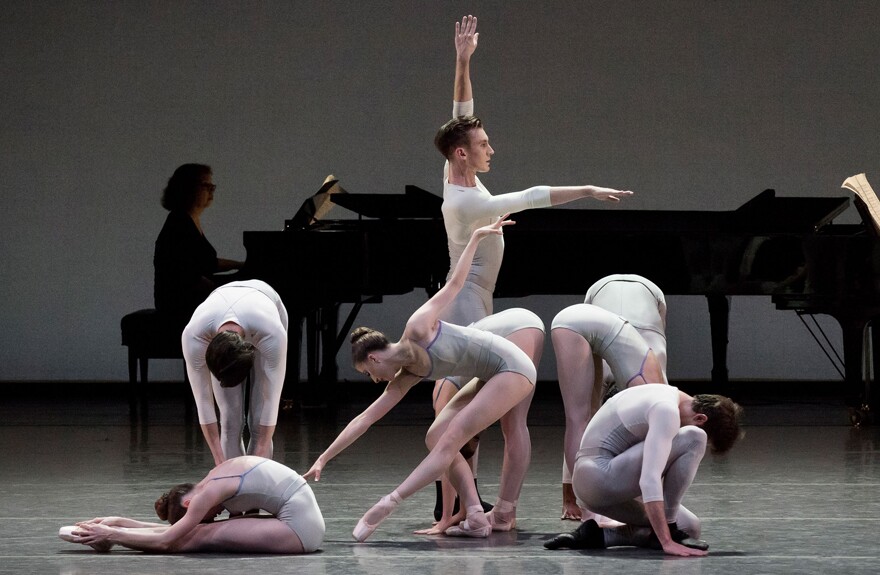Justin Peck’s In Creases, the first work he made for the New York City Ballet, returned to the Saratoga Performing Arts Center Thursday for the first time since its 2012 world premiere. It proved one of the program’s two highlights, the other a superb performance of George Balanchine’s 1946 masterpiece, The Four Temperaments.
In Creases, to two Philip Glass pieces for two pianos, literally springs into action, with eight dancers in two squares, pressing their palms against those of their neighbors until they are propelled backward. The whole ballet teems with such tensed energy. Peck rivets our attention by continually creating anticipation, keeping us involved as well as entertained. When Sara Adams spins joyfully at center stage while the others advance menacingly upon her, Preston Chamblee, at the middle of their attacking line, suddenly snaps them all back with a tug, relieving the tension. Peck then borrows a trick from Balanchine, repeating the sequence from a different angle. Later, Taylor Stanley dances a crooked solo as the other seven watch, signaling Peck’s interest in audiences and response. We see this sequence from a reverse angle as well, for In Creases is a clever ballet that teaches us how to watch it.
The evening began with Jamar Roberts’s new work, Emanon—In Two Movements, to music by jazz saxophonist Wayne Shorter, arranged by Rob Wasserman. Although also for eight dancers, Emanon couldn’t be more different from In Creases. Solos, duets, and larger ensembles tumble after each other like numbers in a variety show, with little tension or coherence. While the dancers excel in Roberts’s jazzed up ballet steps, the dance feels oddly static and doesn’t build to an artistic or emotional payoff.
Christopher Wheeldon’s This Bitter Earth, which premiered a month after In Creases, is a brief, lugubrious affair that sets a slew of troubled romantic mannerisms on Andrew Veyette and Sara Mearns. The dance unfolds to a dreary Max Richter score for strings into which the composer abducted Dinah Washington’s vocal from Clyde Otis’s blues song, stripped of its original instrumentation.
Happily, however, the program ended with a strong performance of The Four Temperaments, Balanchine’s endlessly inventive allegory of the human condition to Hindemith’s music. In the opening Theme, three increasingly strange pas de deux introduce radical, anti-balletic vocabulary that ripples throughout the ballet: flexed instead of pointed feet, right-angled arms flipping up and down, hips thrusting forward out of the balletic line, and women performing splits against the men’s thighs and supported pirouettes on a bent leg. Four variations follow, one for each of the humors that ruled ancient and medieval medicine.
Christopher Grant made a remarkable debut in the Phlegmatic variation as a man so world-weary he must use his hand to lift his foot. Grant understands that Phlegmatic is cold and moist, and he dances with a liquid grace, pincering his arms like an undersea creature and lilting back and forth with his four female companions like seagrass.
In Sanguinic, Chun Wai Chan’s dynamic muscularity in partnering Emilie Gerrity underscores the section’s fierce joy. Sebastian Villarini-Velez’s failed aspirations to the air capture the fearful yet thoughtful brittleness of the Melancholic variation.
In Balanchine’s finale, Choleric, Megan Le Crone proves too hot for Chan to handle. The full cast of twenty-five obsessively reiterates the ballet’s invented vocabulary—the angled arms, the bent knees—looking condemned to mechanistic horror. But then the music shifts from minor to major, and the dancers form horizontal alleys, along which the men run, lifting their partners. They toss them lightly, catch them, and set them back down, and it is glorious. The Four Temperaments shows how even while gravity mandates our return to earth, we are always reaching for the stars.
JAY ROGOFF is a poet and dance writer who lives in Saratoga Springs. His latest poetry collection is Loving in Truth: New and Selected Poems, and he is working on a book about watching the ballets of New York City Ballet founder George Balanchine.
The views expressed by commentators are solely those of the authors. They do not necessarily reflect the views of this station or its management.



